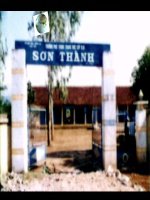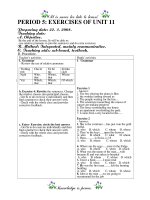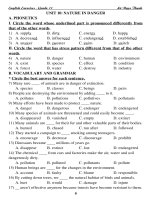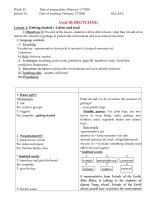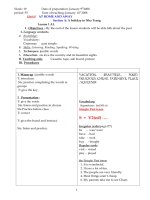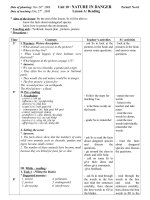unit 10 AV 9
Bạn đang xem bản rút gọn của tài liệu. Xem và tải ngay bản đầy đủ của tài liệu tại đây (187.08 KB, 16 trang )
Week:31 Preparing date: 15/4/08
Period : 61 Teaching date: 18/4/08
Unit 10: Life on other planets
Getting started & Listen and Read
I. Objective: By the end of the lesson, ss will be able to know more about UFOs, learn
some words about this topic & how to use conditional sentences: type 1 & type 2,
review modal verbs may and might
II.. Language contents:
* Vocab: Relating to the planet and life on other planets.
* Grammar: modal verbs: may, might
Conditional sentences: type 1 & type 2
III .Techniques: Guessing words, eliciting, questions & answers, pair/group work
-IV.Teaching aids: cassette, pictures & sub- boards.
- Time : 45 minutes
V. Procedures:
T & ss' activities: content:
• Warm up ( 5'):
- Cut out a shark and a boy.
- Draw some steps, stick the cut out
boy on top of the steps, the shark is in
the sea.
- draw 12 gaps for the word
Unidentified
- Ss guess, if right àone mask
if not à the boy has to
step down.
1/ PRESENTATION (10’)
- T: ask some questions
- What can you see in the pictures?
- What do we call them in
Vietnamese?
- Do you know another word for
UFOs? ( Flying Saucer )
- Do you think they really exist ?
- Have you ever seen any films on
UFOs ?
- Do you want to see a UFO ? What
do you want to know about UFOs ?
- If you saw a UFO, what would you
do
--> U n i d e n t i f i e d
1/ Getting started:
Look at the picture of UFOs (Unidentified
Flying Objects). Ask and answer with a
partner.
*UFOs = Unidentified Flying Objects: Vật thể
bay không xác định
2/ Listen and Read: UFOs are strange flying
objects that some people report they have seen
in the sky and believed to be spacecraft from
another planet. Many scientists do not believe
so. They say that if people see a UFO, it
might be an aircraft, a weather balloon or a
meteor: However; there is still evidence for
people to believe in the existence of UFOs.
* Vocab:
- meteor (n): sao b¨ng
- balloon:(n) kinh khí cầu
- evidence (n): b»ng chøng - anything that
makes clear, shows or proves
- alien (n): ngêi ë hµnh tinh kh¸c - person on
other planets
- spacecraft (n): tµu vò trô
- capture (v): b¾t ( synonym : catch ( by
force ) arrest )
Giao an Tieng Anh lop 9 Ngo thi Hanh Truong THCS Tran Hung Dao
Direct speech Reported speech Direct speech Reported speech
Present simple Past simple this
these
that
those
Present
progressive
Past progressive here there
Future simple
tense
Would + verb now then
can / may could / might today that day
must had to tomorrow The following day
- T shows the pictures on page 83 to
the Ss and asks them some questions
about UFOs
-T: teaches some words
- Ss work in pairs to ask and answer
the questions
- public pairs & corrections
2/PRACTICE (18’)
- T has Ss read the text and find the
words in the text that have the
meanings given in 2a on page 84
- Ss work in pairs to guess
- giving feedback
- public key & corrections
- T guides Ss to do the exercise 2b on
page 84
- T has ss read the text again and
complete the notes individually
- cross check
- public keys & corrections
-Ss: read aloud the completed
sentences
-T: elicit the grammar
* Discussion: (7’)
- T has the whole class discuss the
topic “UFOs”
- Ss work in groups to make a
summary of the evidence of the
existence of UFOs and then discuss
with his / her friends.
- giving feedback
- corrections
- device (n): dông cô, thiÕt bÞ
- claim (v): ®ßi quyÒn, nhËn lµ
a/ Find the words in the text having the
following meanings
1/ proof, support --> evidence
2/ falling star, or shooting star --> meteor
3/ unknown / strange people or things -->
aliens
4/ bringing together or gathering -->
collecting
5/ caught as a prisoner --> captured
6/ became impossible to see --> disappeared
b/ Complete the notes
KEY:
a/ An aircraft, a weather balloon, or a meteor
can be mistaken for an alien spacecraft.
b/ In 1947, a pilot saw nine large round
objects traveling at about 2,800 meters an
hour.
c/ there were over 1, 500 UFO sightings
worldwide in 1952.
d/ In 1954, a woman and her children saw a
UFO above their house.
e/ A farmer saw an egg-shaped object in one of
his fields and also aliens collecting soil
samples in 1964.
f/ In 1971, two men claimed they were
captured by aliens and taken aboard a
spacecraft.
g/ A pilot and his plane disappeared after
sighting a UFO in 1978.
h/ In 1981, a Frenchman reported that he saw
a plate- like device at a treetop 30 meters away
from his garden.
* Note:
If you saw a UFO, what would you do?
- The conditional sentence (type II)
* Discuss:
EX:
- Do you believe UFOs really exit?
- Have you ever seen an alien?
- Can you imagine what the aliens are like ? - -
Are they small or big? Are they intelligent ?
Giao an Tieng Anh lop 9 Ngo thi Hanh Truong THCS Tran Hung Dao
*Homework(6’)
4/ Homework: (5 ')
- Learn the vocabulary
- Prepare unit 5, section: Speak (talk to one
another about the Mars)
SELF EVALUATION : …………………………………………………………
……………………………………………………………………………………………
Week:32 Preparing date:20/4/08
Giao an Tieng Anh lop 9 Ngo thi Hanh Truong THCS Tran Hung Dao
Period:62 Teaching date: 22/4/08
Unit 10: (cont) - Life on other planets
Speak & Listen
I.Objectives: By the end of the lesson, Ss will be able to talk to one another about what
they think there might be on Mars, on the moon and on other planets
- Listening to the text and completing the table. Further practice in
modal verbs may & might
- Practice speaking about Mars.
II. Language contents:
* Vocab: minerals, microorganism, gemstones, creatures . . &. about the moon
* Grammar: may, might, conditional sentences - type 1 & type 2
III.Techniques : eliciting, questions & answers, pair/group work
IV. Teaching aids : pictures & sub- boards.
- Time : 45 minutes
V . Procedures:
T & ss' activities: content:
* Warm up (5'):
- T asks Ss some questions about
the solar system
+ Which planet is the nearest to
the sun ?
+ Which is the biggest ?
+ Which is the hottest ?
- Ss answer the questions
* pre-speaking( 5’)
- T teaches Ss some words by
asking Ss to guess what there are
on Mars.
-Ss: say
- T: write
-T: check
* while- speaking (10’)
* T: set the scene
-T: hang the picture
-Ss: try to guess and match the
drawings with their names.
( group work)
-T: correct
- SS: read the name again
*drill
- Ss work in pairs to do this task
-Mars-SunVocab:
- microorganism (n): vi sinh vËt
- gemstone (n): ®¸ quÝ
- sparkling (a): lÊp l¸nh
- creature (n): sinh vËt
- trace (n): dÊu vÕt
- mineral (n): kho¸ng s¶n
* Note :
- Form: may / might + bare infinitive
- Use: We use may/ might to talk about present or
future possibility
- might is normally a little less sure than may
* Matching:
EX:
1/ minerals
2/ water
3/ mountains
4/ plants
5/ little creatures
6/ gas
7/ gemstone
* Drill:
Giao an Tieng Anh lop 9 Ngo thi Hanh Truong THCS Tran Hung Dao
- public pairs & corrections
- Ss read the model dialogue
- Practice the dialogue in pairs
- Make up similar dialogues in
pairs
*reviews may & might
* post- speaking ( 5’)
- T sets the task
- sts discuss the topic in groups
- public groups & corrections
Use the drawings to drill
- What’s this ?
--> This may be water on Mars.
- What are they ?
--> They may be minerals on Mars.
- What are they ?
--> They might be plants on Mars.
- What’s this ?
--> This may be gas on Mars.
- What are they ?
--> They may be gemstones on Mars.
- What are they ?
--> They may be little creatures on Mars.
* Practice the dialogue
* Make up similar dialogues about the drawings,
using the cues in section a
EX:
A: What do these drawings say ?
B: There may be mountains on Mars.
A: And what about the red signs on the left
corner ?
B: Well, they might be gas on Mars.
* Discussion:
- What may there be on Mercury/ on the moon/ on
Mars ?)
Giao an Tieng Anh lop 9 Ngo thi Hanh Truong THCS Tran Hung Dao
* Warm up (2'):
- T asks Ss to tell some planets in
solar systerm
- ss : say
-T: write
-T: lead in
* pre-listening ( 3’)
-T: Can you guess what there are
on the moon?
-SS: answer
- T teaches ss some words
- T sets the scene: You will listen
to the description of the moon. But
before listening, you should read
the statements on page 86 and
guess which is correct and which
is incorrect
- Sts work in pairs to do the
exercise
- give feedback
* while- listening (5’)
-T: play the tape
-Ss: listen to the tape twice and
checking their predictions
- 3
rd
listening & providing the key
(some sts read the key aloud &
corrections )
* post- listening (8’)
- Talking about the moon
-T: ask
+ Why are there no sounds on the
moon?
+ How many craters are there on
Mars moon
sun earth
- water, air, stones…..
* Listen: Listen to the description of the moon.
Then check the correct statements about the moon.
- Vocab:
- expert (n): a person who has special knowledge,
skill or practice : chuyªn gia
- crater (n): hè (bom), miÖng nói löa
- one- sixth: mét phÇn s¸u
- two- fifths: hai phÇn n¨m
* Answers:
a/ There is no air on the moon
c/ There are no sounds on the moon.
d/ It is very cold at night on the moon.
f/ There are great round holes on the moon.
i/ You will be able to jump very high on the moon.
j/ One day on the moon lasts for two weeks.
Tape transcript
Good evening. Welcome to our Science for Fun
Program. This week we’ve received a lot of
questions asking about life on the moon. We’ve
talked to some experts and this is what we’ve
found out. There is no water or air on the moon. It
is all silent because there is no air. Of course there
will be no music, no sounds. There are no rivers
and no lakes. At night it is very cold. The
temperature goes down to 151
o
C below zero. But
during the day the temperature rises to 100
o
C
above zero.
There are great round holes on the moon. They
Giao an Tieng Anh lop 9 Ngo thi Hanh Truong THCS Tran Hung Dao
Solar
systerm
